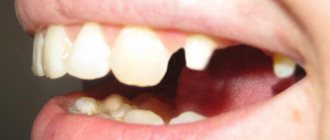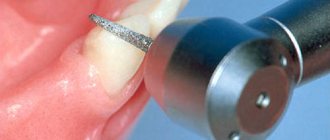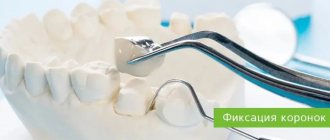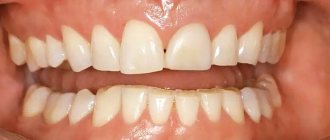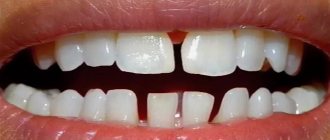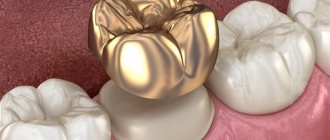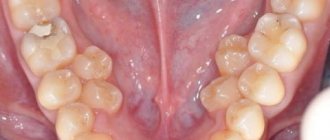Metal and plastic
These are inexpensive crowns that have been placed on the front teeth for decades.
The metal base was covered with an inert synthetic. But time has shown the conventional aesthetics of the structures - over time, the coating darkened and the metal became visible. After a couple of years, a painful replacement of the prosthesis was required. Today, metal-plastic crowns are cheap and can be used for the restoration of molars. But their aesthetic life is maximum 3 years. Therefore, this option is recommended as temporary. Before permanent prosthetics during implantation or in other cases when it is impossible to install a permanent prosthesis immediately after treatment.
Indications
The use of combined microprostheses is indicated for all dental defects that require a prosthetic procedure. The products are used for units visible when smiling and during speech. We are talking about the frontal units and premolars of the upper jaw.
Combined microprostheses are indicated in the presence of defects:
- Unit mobility.
- Severe destruction of the supragingival part of the element, which is not spread by filling or using inlays.
- Irreversible change in enamel shade.
- Reduced height of the lower third of the face due to increased wear of dental elements.
- Edentia.
Can be used for implantation and other clinical situations.
Zirconium dioxide and ceramics
Such dentures are flawless and are recommended for installation on the front teeth. The units are stronger than natural ones due to the stable zirconium frame, and the ceramic coating gives them a visual naturalness, ensuring correct light reflection.
But such a tooth crown is expensive. And it’s not always justified. Modern solid ceramics are close in strength to natural enamel. Therefore, in most cases, frameless ceramics, which are indistinguishable from natural units, are chosen for the restoration of the beauty area.
In addition, Cerec porcelain crowns for front teeth can be made within 1.5 hours; the price of this option is more affordable and its aesthetics are high. The artificial units created using innovative equipment will be flawless, you don’t need to get used to them - their parameters are calculated by a computer program taking into account the anatomical characteristics of a particular patient.
Contraindications for crowns
There are contraindications for placing crowns. The main limitation will be the thickness of the tooth wall. If the pulp is separated from the outer surface by less than 1 cm, then a crown will not be installed. There is a high risk of pulp burns.
Additional contraindications:
- deep bite;
- age up to 16 – 18 years due to immature dentition and thin enamel wall.
- bruxism, due to the high likelihood of crown breakage when grinding teeth.
Arguments for choosing combination crowns
If there is a loss of chewing ability and aesthetic appearance of individual teeth or an entire group, it is advantageous to choose combined columns. They are durable and inexpensive. The best option is metal-free oxide zirconium, but they have a high price.
All-ceramic models would be a good design, but they are not suitable for anterior teeth. Chewing requires extra strength. The price of these models is higher than that of combined crowns.
Description of species
The frames of different types of crowns are made using the same technology. They differ in cladding.
- Metal-plastic
Polymethacrylate is applied to the metal base. These crowns look decent and have a low price. Disadvantages: they wear out quickly, don’t stain well to match the tooth color, and don’t last long.
- Metal-ceramic
The coating is glass ceramics. The crowns are durable, installed on molars and premolars, look aesthetically pleasing, and have a moderate cost. Disadvantage: large thickness. You have to grind down the tooth a lot.
- Metal + composite
Metal composite is a mixture of organic resins with ceramic microparticles. The material wears off quickly, is stained by food over time, and plaque is deposited on it. But composites are quickly manufactured, have high flexural strength, and are repaired in the patient’s mouth.
Installation of crowns
The doctor examines the patient, selects a model, grinds the teeth, makes crowns, and installs temporary models. The frame is cast, sintered with the cladding and the outer surface is processed. The crown is connected to the treated tooth using cement.
Duration of service
The service life of the veneer on crowns depends on various factors. It is important for the doctor to follow the technology and for the patient to properly care for the oral cavity. Approximate service life:
- metal ceramics – from 10 to 15 years;
- metal composite – from 5 to 15 years depending on the brand of materials;
- metal-plastic – up to 5 years.
For plastic, peeling from metal is terrible, for other materials - chips and cracks. Composite materials are repaired in the mouth, and the remaining crowns are removed.
Metal ceramics
If it is necessary to replace molars, ceramics will not be suitable; the material is too fragile and will not withstand the increased load. Therefore, it is more reasonable to install metal-ceramic or zirconium crowns on chewing teeth. The last segment is more expensive. Therefore, many patients choose a metal cast crown coated with ceramics.
Modern frames are made only by casting. This ensures a tight fit of the crown in the remains of the natural tooth, preventing the entry of pathogenic microflora into the tooth.
Options for manufacturing cast crowns –
Solid crowns can be made not only entirely from one metal, for example, a cobalt-chromium alloy. Their surface can also be sprayed with a yellow tint, or the front surface of the crowns can be lined with a more aesthetically acceptable material, for example, plastic. Also, cast crowns can be combined with metal-ceramic ones in one bridge prosthesis (we will also talk about this prosthetic option below)
- One-piece crown without sputtering (Fig. 1, 2, 4) - we have already said above that such crowns will look like the most ordinary well-polished metal.
- Solid crown with sputtering (Fig. 3) – if the patient is not satisfied with the color of shiny polished metal, then it is possible to spray such crowns with a “gold” look. These are already so-called metal crowns with spraying. However, it should be noted that spraying may have some negative effects on the oral mucosa due to the occurrence of electrochemical reactions (microcurrents). This phenomenon is called "galvanosis".
- One-piece crown with veneer (Fig. 5) - a one-piece crown with veneer has an overlay made of plastic or ceramic on the front surface (which is visible when smiling). However, it should be noted that such crowns often have chips of plastic/ceramics. The cost of a cast crown with ceramic lining will not be much lower than that of a metal-ceramic crown, lined with ceramic on all sides. A cheaper option is also possible: veneering with plastic (such crowns are called “metal-plastic”).
- Combined bridges (Fig. 6) - when making a bridge with supports for the 5th and 7th teeth, it is not necessary to make the entire bridge from 3 crowns - entirely from metal ceramics. You can make metal-ceramic only teeth that fall into the smile line, for example, only 5 or 5-6 teeth (as in Fig. 6). The remaining crowns will be made without ceramic veneer, i.e. solid cast.
When are combined crowns installed?
Metal-ceramics can be installed if a large tooth crown is destroyed; the frame will protect the remains of the molars from excessive loads.
Metal ceramics are installed:
- For a real tooth with a healthy, strong root that has crumbled by 50% or more.
- As part of the bridge structure - crowns on the supporting teeth.
- As a final prosthesis on implants.
The option is quite worthy for maintaining the function of chewing teeth and helping to preserve the structure of periodontal tissues.
But in general, if a tooth is more than 50 percent damaged, it is more advisable to install a Cerec module, and the tooth restored in this way will serve you for many more years.
Preparing teeth for crowns – should I be afraid of it?
Some patients become fearful after receiving information from a doctor that they must undergo a procedure such as tooth preparation before installing crowns. This happens because many people have no idea what it is? In practice, dissection acts as an important preparatory step and should not cause negative emotions at all.
Why is preparation necessary?
Due to the fact that the manufacture of crowns can be made from completely different materials, this feature should be taken into account at the preparatory stage of the teeth for the installation of dentures. Many patients are interested in the question: what is special about this procedure?
At the time of its implementation, the teeth are ground, thanks to which a special place is formed for installing crowns. Preparation is the first step towards starting prosthetics. But this process has some differences that are directly dependent on the type of crown being installed.
Subtleties of tooth preparation, based on the type of crown
• Installation of a one-piece crown involves grinding the tooth in a circle to the level of the tooth neck. The height of the fabric is removed to a thickness of approximately 1.5 mm. This procedure makes it possible to protect nearby teeth from damage.
• To install a metal-ceramic crown, the doctor must remove up to 2 mm of dentin and tooth enamel from all sides. This procedure is performed in order to give the stump the appearance of a truncated cone. In addition, you will need to make a special ledge in the place where the tooth turning area begins. As a result of such manipulations, a reliable fit of the fixed crown to the tooth surface is ensured. In order for the prosthesis to be secured as firmly as possible, the surfaces of the stump should have a slight roughness.
• Before installing a temporary crown, you will need to form a special rounded ledge, which will sink into the gum tissue about 0.1 mm. The stump will have to have a cone-shaped or cylindrical shape.
How to make a quality tooth preparation
Specialists of the Center for Dentistry of Innovative Technologies named after. Tikhonov, before starting prosthetics, all the required procedures are carried out. Their list includes not only tooth preparation for crowns, but also complete sanitation of the oral cavity, including professional hygiene. High-quality patient care here becomes possible thanks to the use of vast practical experience, a personal approach to patients, and the use of the latest modern equipment.
Advantages
Due to the metal base, combined crowns are stronger than real teeth. With proper care, their service life is 15 years
.
Additional advantages:
- They do not lose their shape or shade.
- Visually close to natural enamel. Therefore, they are invisible against the background of neighboring molars when laughing or talking.
- Reliable protection and functionality - you can safely chew your usual food.
- The risk of allergies is minimal (traditionally, up to 2% of people are sensitive to alloys).
When installed correctly, it adheres to the gum and tooth, protecting the units
Advantages and disadvantages
Combined models are an economical solution for row restoration. They retain functionality, provide the aesthetics of the range, and are relatively inexpensive. Various materials are used for manufacturing; the best solutions are ceramics and metal-free ones using zirconium oxide. Installation is simple, quick, and the service life of such crowns is up to fifteen years. In this case, the tooth is preserved; only turning is needed for installation. There are not many disadvantages, they depend on the materials used.
Manufacturing and installation of combined crowns
To put a metal-ceramic crown on your teeth (cost – 17,900 rubles / tooth), it will take 7-14 days
.
Manufacturing sequence:
- The tooth is prepared to the thickness of the crown.
- An impression is taken from which a cast crown is made.
- It is advisable to install temporary plastic protection on treated teeth.
- A metal frame is made and tried on.
- If adjustments are needed, they are made, and another fitting follows. When the artificial tooth fits, the metal is coated with ceramic.
- During installation, the tooth is covered with a protective compound, and the prosthesis is fixed with dental cement.
A nuance: the ceramics are applied in layers, each layer is baked in an oven under high temperature. Therefore, the coating is stable and securely attached to the metal base. Contact me at the dentist and we will decide what crown to put on the tooth in your case.
All the pros and cons
Combined crowns are an economical solution to the problem of functionality and aesthetics of the dentition. Expensive metal-free structures made of zirconium oxide can ensure the strength and attractiveness of teeth.
All-ceramic products are installed on the frontal zone. Due to their low strength, such dentures are not suitable for fixation on chewing elements. The cost of this model is higher than that of the combined ones.
Varieties
The market offers three types of microprostheses: metal-composite, metal-ceramic and metal-plastic. The base production technology is the same. The difference lies in the cladding.
Metal-plastic
Metal microprostheses with an outer layer of polymethacrylate. Cladding material is available in different forms. Various technologies for applying external coating are used.
Plastic does not enter into a chemical bond with metal. Special liquids can increase the adhesion force. This eliminates the need for retention.
Production technology:
- After the casting or stamping procedure is completed, the frame is sandblasted and degreased.
- Modeling a plastic crown with wax on a plaster model of the unit, made from an impression.
- Packing the model into molding mass, removing wax during heating.
- Filling the cavity with plastic under pressure.
It is possible to use other methods of applying the composition. For example, layer-by-layer application of a polymer composition with a brush (spatula). Each layer is polymerized.
The technology for applying the composition is determined by the original form. Polymer coating is supplied in powder and liquid form. The components are mixed immediately before use in certain proportions.
According to the curing method, the material can be cold or hot polymerization.
Metal-ceramic
The cladding is glass ceramics. The starting material is ceramic powder diluted in liquid. The material is applied layer by layer with each layer being fired in an oven. After processing, the product is fitted to the tooth, refined and glazed.
Durable microprostheses are suitable for installation in the chewing and frontal areas. They are distinguished by aesthetics, functionality and durability. Disadvantage - the thickness of the crown in some places reaches 2 mm.
Metal composite
Composite mass is a hybrid composition consisting of organic resins and tiny ceramic particles. The composition is applied to the base and polymerized with a lamp. The pros and cons of a composite are determined by the specific material. The products are inferior in quality to ceramic structures. It is possible to repair metal-composite dentures in the patient’s mouth if there are clinical indications.
Step-by-step installation algorithm
Manufacturing and fastening of a metal-ceramic structure with a solid base includes the following steps:
- Inspection and diagnostics.
- Product selection.
- Turning of the support element.
- Production of microprosthesis.
- Making impressions and casting the frame.
- Fitting the base to the unit.
- Determining the shade of artificial enamel.
- Sintering of the ceramic layer.
- Fitting, correction.
- Glazing, final processing.
- Fastening to the element using cement.
Important points to remember:
1) You should not get solid metal crowns if you have a metal allergy. To be sure, you can test your body's sensitivity to metals. It is very important that the cobalt-chromium alloy from which your artificial crowns or bridges will be made does not contain beryllium or nickel. These additives significantly increase the risk of developing allergies and inflammation of the gums around the crowns.
2) If you already have metal crowns on your teeth (including metal-ceramic), this could be a potential problem. The fact is that the presence of different metal alloys in the oral cavity will definitely lead to the development of electrochemical reactions, i.e. galvanosis will develop. The latter may be characterized by a constant unpleasant metallic taste in the mouth, burning, and the development of diseases of the oral mucosa.
Therefore, only one version of the cobalt-chromium alloy should be used in one patient for prosthetics with solid-cast and metal-ceramic crowns. But even in this case, the risk of developing galvanosis will be present, although it will be significantly lower. Therefore, if you already have metal-ceramics or cast crowns, it is safer to make ceramic crowns from pressed ceramics or zirconium dioxide. We hope that our article on the topic: Reviews of solid crowns was useful to you!
Sources:
1. Personal experience as a dentist, 2. “Orthopedic dentistry. Textbook" (Trezubov V.N.), 3. National Library of Medicine (USA), 4. https://www.realself.com/, 5. "Crowns and bridges in orthopedic dentistry" (Smith B.).
Indications and contraindications for the installation of porcelain crowns
| Indications: | Contraindications: |
|
|


